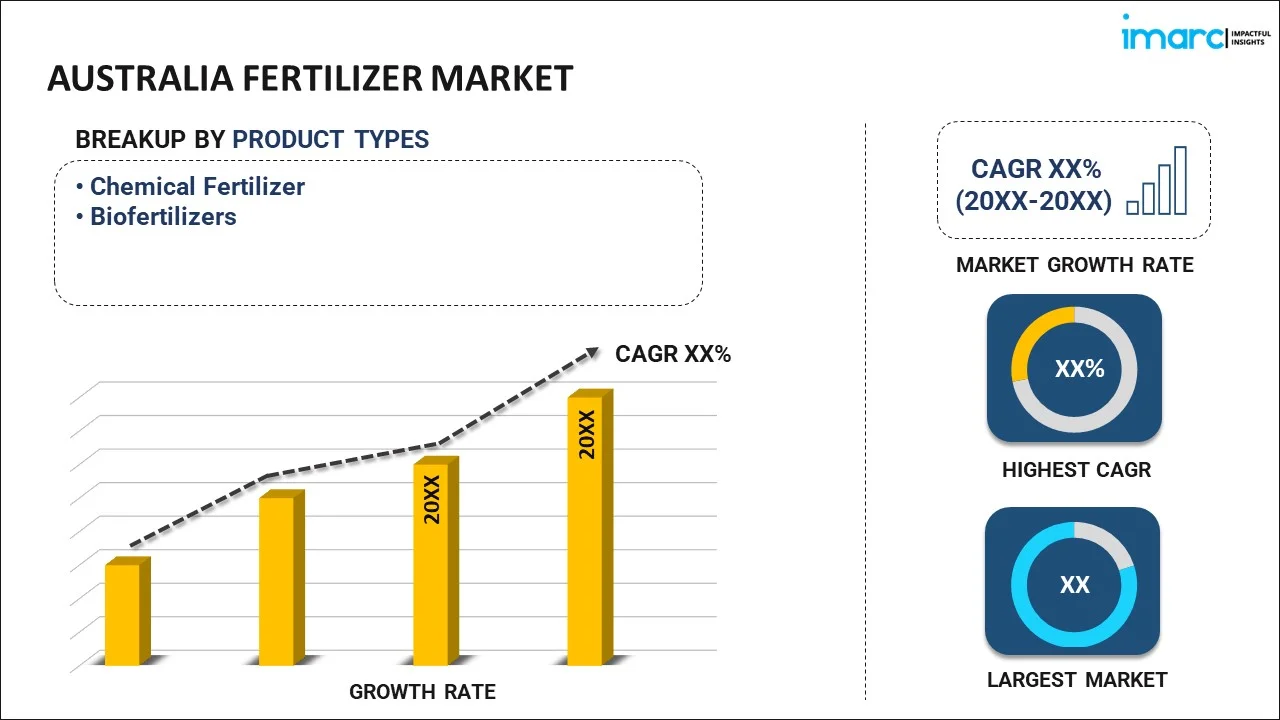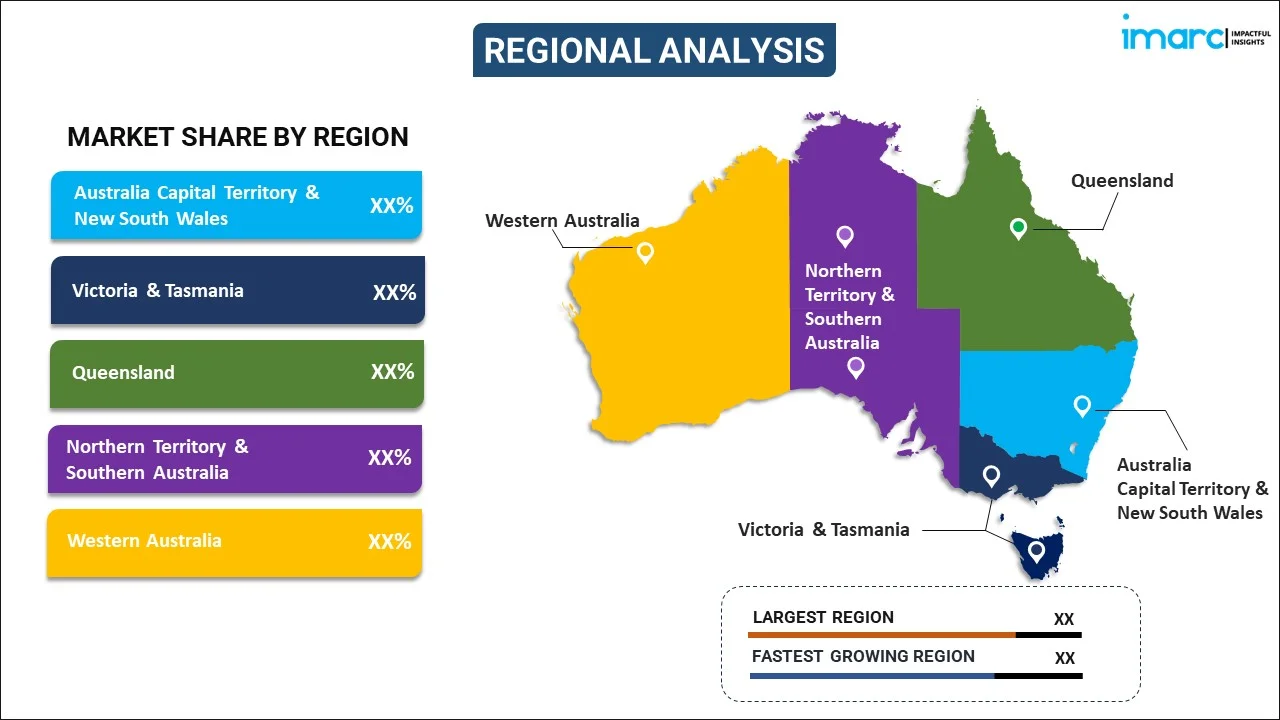
Australia Fertilizer Market Report by Product Type (Chemical Fertilizer, Biofertilizers), Product (Straight Fertilizers, Complex Fertilizers), Product Form (Dry, Liquid), Crop Type (Grains and Cereals, Pulses and Oilseeds, Fruits and Vegetables, Flowers and Ornamentals, and Others), and Region 2025-2033
Market Overview:
Australia fertilizer market size is projected to exhibit a growth rate (CAGR) of 1.71% during 2025-2033. The increasing preferences among farmers across the country towards organic product variants that promote soil health and minimize ecological impact are primarily driving the market growth.
|
Report Attribute
|
Key Statistics
|
|---|---|
|
Base Year
|
2024 |
|
Forecast Years
|
2025-2033 |
|
Historical Years
|
2019-2024
|
| Market Growth Rate (2025-2033) | 1.71% |
Fertilizer is a chemical substance applied to land or soil to increase crop yield. The main purpose is to enhance the growth and productivity of plants by supplying essential nutrients. These nutrients, such as nitrogen, potassium, phosphorus, etc., are crucial for plant development. Additionally, it improves the soil's ability to retain water. Fertilizer is broadly categorized into organic and inorganic types. Organic fertilizers, derived from plants and animals, are natural and contribute to an increase in organic matter in the soil. They stimulate microbial reproduction and bring about changes in the soil's physical and chemical composition. In contrast, inorganic fertilizers are synthetic chemicals produced through artificial methods. Fertilizers are easy to transport, store, apply, etc. They readily dissolve in the soil. In line with this, these substances are also known for their predictability, reliability, and swift impact on crops. Consequently, they play a vital role in fostering plant health and maximizing agricultural output.
Australia Fertilizer Market Trends:
The Australia fertilizer market is experiencing significant growth, driven by various key factors. Firstly, the expanding agricultural sector, coupled with the growing awareness among individuals towards the importance of soil nutrition, is augmenting the market growth across the country. Moreover, advancements in agricultural practices and the increasing trend of precision farming contribute to the escalating demand for specialized fertilizers in Australia. These innovations enable farmers to tailor nutrient applications to specific crop needs, fostering efficiency and sustainability. Additionally, the elevating focus on sustainable and organic farming practices is also positively influencing the market growth across the country. The changing climate and its impact on soil conditions further drive the need for adaptive fertilization strategies. Apart from this, farmers across the country are exploring fertilizers with enhanced water retention capabilities to address varying climate patterns and ensure optimal plant nutrition. Furthermore, strategic collaborations between fertilizer manufacturers and research institutions lead to the development of advanced formulations and technologies, which is expected to fuel the market growth in Australia over the forecasted period.
Australia Fertilizer Market Segmentation:
IMARC Group provides an analysis of the key trends in each segment of the market, along with forecasts at the country level for 2025-2033. Our report has categorized the market based on product type, product, product form, and crop type.
Product Type Insights:

- Chemical Fertilizer
- Biofertilizers
The report has provided a detailed breakup and analysis of the market based on the product type. This includes chemical fertilizer and biofertilizers.
Product Insights:
- Straight Fertilizers
- Nitrogenous Fertilizers
- Urea
- Calcium Ammonium Nitrate
- Ammonium Nitrate
- Ammonium Sulfate
- Anhydrous Ammonia
- Others
- Phosphatic Fertilizers
- Mono-Ammonium Phosphate (MAP)
- Di-Ammonium Phosphate (DAP)
- Single Super Phosphate (SSP)
- Triple Super Phosphate (TSP)
- Others
- Potash Fertilizers
- Muriate of Potash (MoP)
- Sulfate of Potash (SoP)
- Secondary Macronutrient Fertilizers
- Calcium Fertilizers
- Magnesium Fertilizers
- Sulfur Fertilizers
- Micronutrient Fertilizers
- Zinc
- Manganese
- Copper
- Iron
- Boron
- Molybdenum
- Others
- Nitrogenous Fertilizers
- Complex Fertilizers
A detailed breakup and analysis of the market based on the product have also been provided in the report. This includes straight fertilizers [nitrogenous fertilizers (urea, calcium ammonium nitrate, ammonium nitrate, ammonium sulfate, anhydrous ammonia, and others), phosphatic fertilizers (mono-ammonium phosphate (MAP), di-ammonium phosphate (DAP), single super phosphate (SSP), triple super phosphate (TSP), and others), potash fertilizers (muriate of potash (MoP) and sulfate of potash (SoP)), secondary macronutrient fertilizers (calcium fertilizers, magnesium fertilizers, and sulfur fertilizers), micronutrient fertilizers (zinc, manganese, copper, iron, boron, molybdenum, and others)], and complex fertilizers.
Product Form Insights:
- Dry
- Liquid
The report has provided a detailed breakup and analysis of the market based on the product form. This includes dry and liquid.
Crop Type Insights:
- Grains and Cereals
- Pulses and Oilseeds
- Fruits and Vegetables
- Flowers and Ornamentals
- Others
A detailed breakup and analysis of the market based on the crop type have also been provided in the report. This includes grains and cereals, pulses and oilseeds, fruits and vegetables, flowers and ornamentals, and others.
Regional Insights:

- Australia Capital Territory & New South Wales
- Victoria & Tasmania
- Queensland
- Northern Territory & Southern Australia
- Western Australia
The report has also provided a comprehensive analysis of all the major regional markets, which include Australia Capital Territory & New South Wales, Victoria & Tasmania, Queensland, Northern Territory & Southern Australia, and Western Australia.
Competitive Landscape:
The market research report has also provided a comprehensive analysis of the competitive landscape in the market. Competitive analysis such as market structure, key player positioning, top winning strategies, competitive dashboard, and company evaluation quadrant has been covered in the report. Also, detailed profiles of all major companies have been provided.
Australia Fertilizer Market Report Coverage:
| Report Features | Details |
|---|---|
| Base Year of the Analysis | 2024 |
| Historical Period | 2019-2024 |
| Forecast Period | 2025-2033 |
| Units | Million USD |
| Scope of the Report | Exploration of Historical Trends and Market Outlook, Industry Catalysts and Challenges, Segment-Wise Historical and Future Market Assessment:
|
| Product Types Covered | Chemical Fertilizer, Biofertilizers |
| Products Covered |
|
| Product Forms Covered | Dry, Liquid |
| Crop Types Covered | Grains and Cereals, Pulses and Oilseeds, Fruits and Vegetables, Flowers and Ornamentals, Others |
| Regions Covered | Australia Capital Territory & New South Wales, Victoria & Tasmania, Queensland, Northern Territory & Southern Australia, Western Australia |
| Customization Scope | 10% Free Customization |
| Post-Sale Analyst Support | 10-12 Weeks |
| Delivery Format | PDF and Excel through Email (We can also provide the editable version of the report in PPT/Word format on special request) |
Key Questions Answered in This Report:
- How has the Australia fertilizer market performed so far and how will it perform in the coming years?
- What has been the impact of COVID-19 on the Australia fertilizer market?
- What is the breakup of the Australia fertilizer market on the basis of product type?
- What is the breakup of the Australia fertilizer market on the basis of product?
- What is the breakup of the Australia fertilizer market on the basis of product form?
- What is the breakup of the Australia fertilizer market on the basis of crop type?
- What are the various stages in the value chain of the Australia fertilizer market?
- What are the key driving factors and challenges in the Australia fertilizer?
- What is the structure of the Australia fertilizer market and who are the key players?
- What is the degree of competition in the Australia fertilizer market?
Key Benefits for Stakeholders:
- IMARC’s industry report offers a comprehensive quantitative analysis of various market segments, historical and current market trends, market forecasts, and dynamics of the Australia fertilizer market from 2019-2033.
- The research report provides the latest information on the market drivers, challenges, and opportunities in the Australia fertilizer market.
- Porter's five forces analysis assist stakeholders in assessing the impact of new entrants, competitive rivalry, supplier power, buyer power, and the threat of substitution. It helps stakeholders to analyze the level of competition within the Australia fertilizer industry and its attractiveness.
- Competitive landscape allows stakeholders to understand their competitive environment and provides an insight into the current positions of key players in the market.
Need more help?
- Speak to our experienced analysts for insights on the current market scenarios.
- Include additional segments and countries to customize the report as per your requirement.
- Gain an unparalleled competitive advantage in your domain by understanding how to utilize the report and positively impacting your operations and revenue.
- For further assistance, please connect with our analysts.
 Inquire Before Buying
Inquire Before Buying
 Speak to an Analyst
Speak to an Analyst
 Request Brochure
Request Brochure
 Request Customization
Request Customization




.webp)




.webp)












